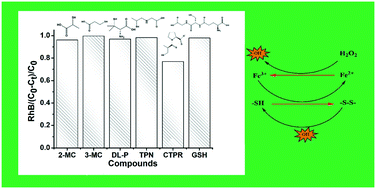Glutathione promoted Fenton degradation: a cocatalyst based on the –HS/–S–S– cycle with hydroxyl radicals†
Abstract
Glutathione, a kind of tripeptide with a thiol group, was introduced into the traditional Fenton system. It was found that target pollutant degradation is greatly improved when adding glutathione into the Fenton system, due to it accelerating the Fe(II)/Fe(III) cycle, thus generating more hydroxyl radicals. The variation of the concentrations of Fe(II) and H2O2 and the generation of HO· were monitored to verify the catalytic action of glutathione. Operating variables such as pH, molar ratios and different atmospheres were examined, and cyclic degradation experiments were performed to explore the stability of catalysts. Electrospray ionization mass spectrometry (ESI-MS) was used to determine the transformation of different forms of glutathione to explore the catalytic mechanism. More importantly, it was found that other thiol compounds can also promote the Fenton degradation through a cycle of thiol compounds and their oxidized forms. In conclusion, it is a cocatalyst based on the –HS/–S–S– cycle with hydroxyl radicals, which has not been reported previously.

- This article is part of the themed collection: Environmental Science: Water Research & Technology Cover Art


 Please wait while we load your content...
Please wait while we load your content...